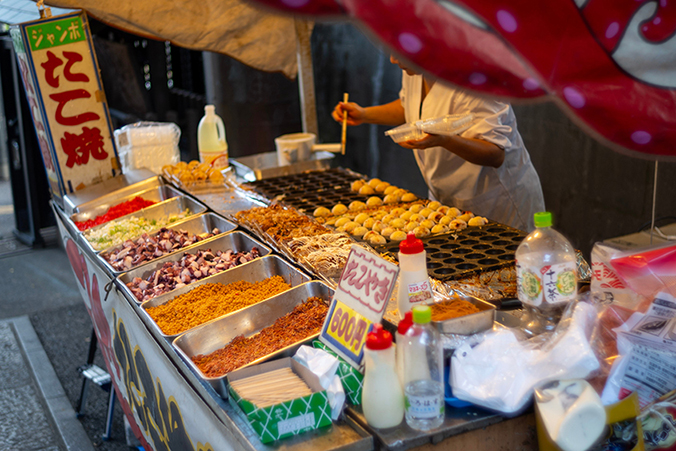In Japan, festivals—known as matsuri—are vibrant cultural celebrations that blend centuries-old religious practices with seasonal joy and community spirit. While each region has its own unique customs, rituals, and performances, there is one element that unites all matsuri: food. The colorful, sizzling, and sweet-smelling stalls that line temple paths and festival grounds form the heart of the matsuri experience. These foods are more than snacks; they are cultural icons, comfort memories, and edible embodiments of celebration. Understanding matsuri food traditions opens a flavorful window into Japan’s festive spirit, its regional diversity, and its culinary creativity.

A Culinary Journey Through Festival Streets
From the moment you step into a matsuri, the aroma of grilled corn, soy sauce-glazed rice cakes, and sweet custard fills the air. Yatai—temporary food stalls—line the streets, each offering a signature dish cooked right in front of your eyes. These stalls often open in the late afternoon and remain bustling late into the night, creating a sensory-rich corridor of flavors, music, lanterns, and laughter.
Among the most iconic festival foods is takoyaki, a Kansai-region specialty consisting of soft, round balls filled with octopus pieces, tempura flakes, green onions, and pickled ginger. Cooked in special molded pans, they are flipped expertly with chopsticks and topped with savory sauce, mayonnaise, and dried bonito flakes. Equally beloved is yakisoba — stir-fried noodles with vegetables and pork, seasoned with a tangy-sweet sauce and served hot from the grill.
No matsuri is complete without sweet treats. Taiyaki, a fish-shaped pancake filled with red bean paste or custard, is a nostalgic favorite. Kakigōri, or shaved ice drenched in colorful syrups, provides relief during summer festivals, while ringo ame (candied apples) and choco banana (chocolate-covered bananas on sticks) delight children and adults alike. These offerings not only satisfy the appetite but also evoke joyful memories and a sense of timeless indulgence.
Cultural Significance and Seasonal Influence
Matsuri food is deeply tied to the seasons and the Shinto and Buddhist roots of the festivals themselves. Spring festivals often coincide with cherry blossom viewing (hanami) and feature light, colorful fare like sakura mochi and hanami dango. Summer festivals, such as those held during Obon, emphasize refreshing treats like kakigōri and cooling cucumber skewers. In autumn, harvest festivals bring roasted sweet potatoes (yaki-imo) and grilled chestnuts, connecting the celebration to the fruits of the land.
The foods served at matsuri also reflect Japan’s rich regional diversity. For example, in Hiroshima, okonomiyaki (savory pancakes) are often layered with noodles and cabbage, while in Aomori, seafood skewers made from locally caught squid or scallops are popular. Some regions offer unique specialties: Hokkaido matsuri may serve zangi (fried chicken) or butadon (pork rice bowls), while Kyushu festivals might include karashi renkon (mustard-stuffed lotus root). Each bite tells a story of place, tradition, and climate.
Food stalls also play a symbolic role, representing abundance, gratitude, and community. The sharing of food in festival spaces reflects a broader cultural emphasis on connection and celebration. Whether shared among friends, family, or strangers, eating matsuri food is a communal act, binding participants through warmth and indulgence.
Modern Evolutions and Global Appeal
In recent years, matsuri food culture has evolved to reflect modern tastes and influences. Alongside traditional favorites, you may now find cheese-filled mochi, matcha bubble tea, and Korean-inspired hot dogs. These additions, often introduced by younger generations of vendors, demonstrate the dynamic nature of matsuri food, blending nostalgia with innovation.
The visual appeal of matsuri food has also gained attention in the age of social media. Bright colors, playful designs, and dramatic preparation techniques make festival foods highly shareable. From slow-motion videos of mochi being pounded to artistic taiyaki cut in half to reveal lava-like fillings, matsuri food has become a feast not only for the palate but also for the eyes.
Outside Japan, matsuri-inspired food stalls and night markets have gained popularity at Japanese cultural festivals around the world. Whether in New York, Sydney, or Bangkok, the smell of yakisoba or the sight of colorful dango evokes the essence of Japanese celebration. These festivals not only introduce Japanese cuisine to broader audiences but also preserve the emotional and cultural core of matsuri.
While some traditionalists voice concern about over-commercialization, most agree that the adaptability of matsuri food is a sign of its resilience. It continues to bring people together, celebrate local identity, and remind participants—no matter their origin—of the joy of a summer night spent beneath lanterns, with a snack in hand and music in the air.
More Information
Where to Experience Matsuri Food:
- Asakusa Sanja Matsuri (Tokyo, May): One of the liveliest festivals in Tokyo, known for endless yatai.
- Gion Matsuri (Kyoto, July): Famous for traditional foods and sweets.
- Nebuta Matsuri (Aomori, August): Northern specialties like squid skewers and miso oden.
- Tenjin Matsuri (Osaka, July): Classic Kansai street food in abundance.
Recommended Treats:
- Savory: Takoyaki, Yakisoba, Okonomiyaki, Ikayaki (grilled squid)
- Sweet: Taiyaki, Kakigōri, Ringo Ame, Choco Banana, Hanami Dango
Tips:
- Bring cash: Most yatai are cash-only.
- Come hungry: Portion sizes are perfect for trying multiple dishes.
- Go early for family-friendly times, or after sunset for the full festive atmosphere.










